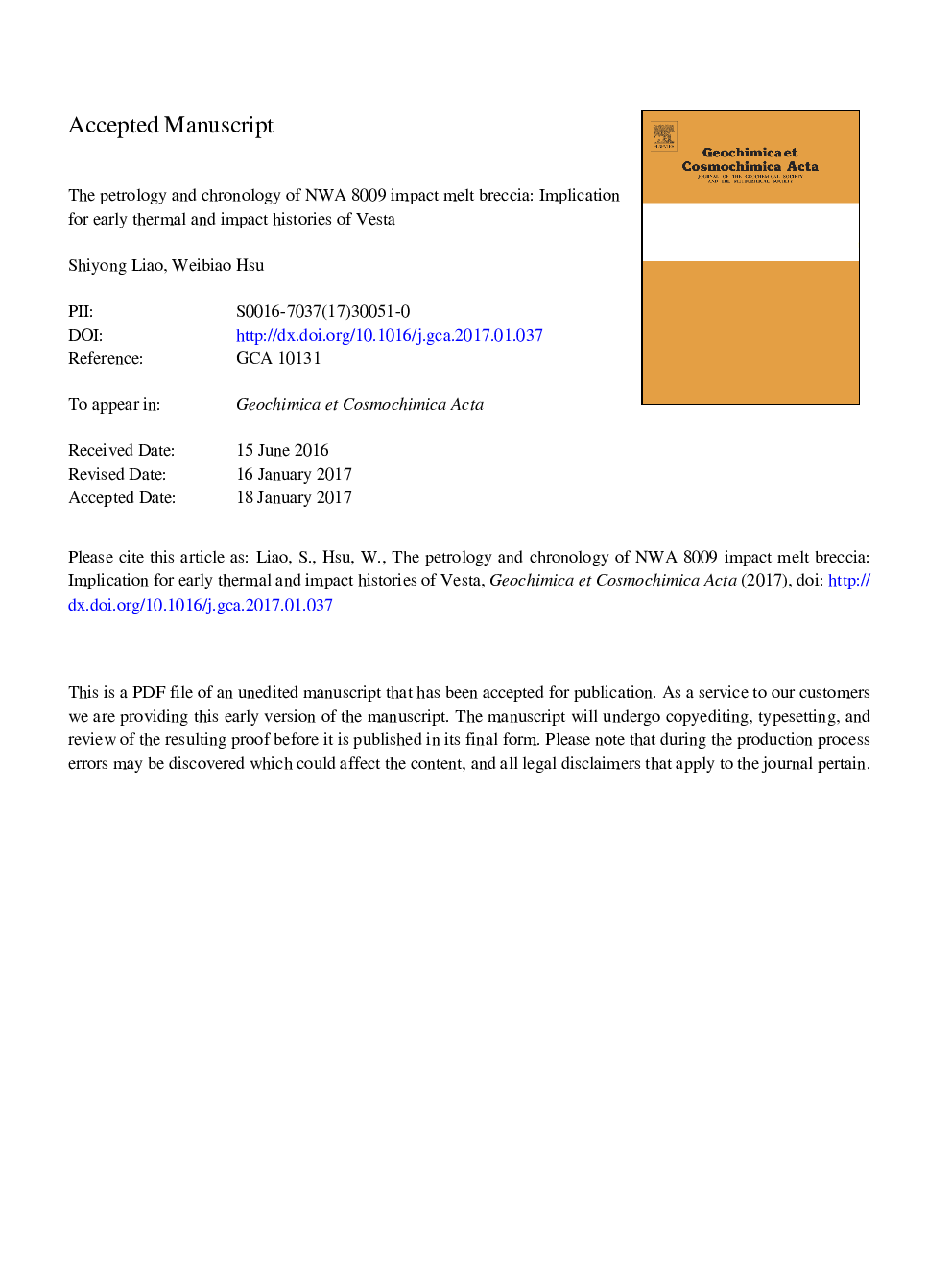| کد مقاله | کد نشریه | سال انتشار | مقاله انگلیسی | نسخه تمام متن |
|---|---|---|---|---|
| 5783544 | 1637953 | 2017 | 62 صفحه PDF | دانلود رایگان |
عنوان انگلیسی مقاله ISI
The petrology and chronology of NWA 8009 impact melt breccia: Implication for early thermal and impact histories of Vesta
دانلود مقاله + سفارش ترجمه
دانلود مقاله ISI انگلیسی
رایگان برای ایرانیان
کلمات کلیدی
موضوعات مرتبط
مهندسی و علوم پایه
علوم زمین و سیارات
ژئوشیمی و پترولوژی
پیش نمایش صفحه اول مقاله

چکیده انگلیسی
Studies of petrology, mineralogy and geochronology of eucrites are keys to reconstruct the thermal and impact history of 4 Vesta, the proposed parent body for HED meteorites. Here we report the petrography, mineralogy and geochemistry of NWA 8009, a newly found eucritic impact-melt breccia, and present SIMS U-Pb ages of zircon and phosphates. NWA 8009 consists of coarse- and fine-grained lithic and mineral clasts set in fine-grained recrystallized matrix. It was derived from a protolith of monomict non-cumulate eucrite. Evidence for intense shock metamorphism observed in NWA 8009 includes mosaicism, deformed exsolution lamellae and partial melting of pyroxene, melting and incipient flow of plagioclase, planar fractures and granular textures of zircon. These shock effects indicate NWA 8009 was subjected to an impact metamorphism with peak pressure of â¼50-60 GPa and post-shock temperature of â¼1160-1200 °C. NWA 8009 is among the most intensely shocked HEDs reported yet. After the impact, the sample was buried near the surface in target rocks and experienced rapid cooling (â¼23 °C/h) and annealing, resulting in recrystallization of the matrix and devitrification of plagioclase and silica glasses. U-Pb isotopic system of apatite within plagioclase groundmass of lithic clasts is completely reset and constrains the timing of impact at 4143 ± 61 Ma, providing a new robust impact age on Vesta. Combined with the presence of synchronous impact resetting events, especially those recorded by Lu-Hf, Sm-Nd, and Pb-Pb isotopic systems, we identified a period of high impacts flux at ca. 4.1-4.2 Ga on Vesta. This impact flux occurred coincident with the uptick at ca. 4.1-4.2 Ga in impact age spectra of the moon, probably reflects widespread intense bombardment throughout the inner solar system at ca. 4.1-4.2 Ga. Based on evidence from zircon chemical zoning, petrographic occurrences, as well as the distinctive Zr/Hf ratios, we suggested that zircons in NWA 8009 have had a metamorphic, instead of magmatic origin. They mainly crystallized from melts produced by partial melting of mesostasis area due to reheating event during early global thermal metamorphism, rather than by Zr release from Zr-rich minerals. The U-Pb isotopic system in zircons was not disturbed by subsequent impacts, the weighted-mean 207Pb/206Pb age of 4560 ± 8 Ma represents the timing of zircon growth during thermal metamorphism. Zircons from NWA 8009 and other eucrites may share a common origin during metamorphic growth events, and constraining the global thermal metamorphism on Vesta at ca. 4.55 Ga. The main heat sources responsible for global metamorphism in basaltic crust of Vesta might be heating from the hot interior, especially heat flow related to magmatism, rather than impact.
ناشر
Database: Elsevier - ScienceDirect (ساینس دایرکت)
Journal: Geochimica et Cosmochimica Acta - Volume 204, 1 May 2017, Pages 159-178
Journal: Geochimica et Cosmochimica Acta - Volume 204, 1 May 2017, Pages 159-178
نویسندگان
Shiyong Liao, Weibiao Hsu,